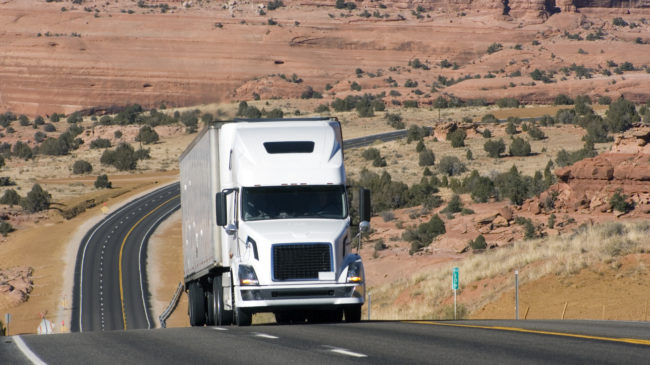In their daily lives, most Americans probably take the crucial role freight transportation plays in delivering the goods we all use for granted. Likewise, policymakers often think ribbon-cutting ceremonies, building a new light rail line or opening a new terminal at an airport are sexier than widening an existing highway. But at this time, while government-imposed shutdowns and social distancing lead to a 90 percent decline in transit and aviation demand, America’s road freight system is playing a critical role in the parts of the economy that are still open and moving.
The Interstate Highway System has improved the United States in many ways. It improved the transportation of goods, expanded markets, and enhanced competition. It helped connect areas and decreased travel times to help increase business efficiency. Between 1957 and 1996, the Interstate system contributed an estimated $3.5 to $4.1 trillion to the American economy, adjusted for inflation.
One of the primary reasons for building the Interstate system was national defense, but clearly the current value in Interstate highways is moving goods, not troops. And as COVID-19 has locked down nine in 10 Americans, the Interstate system’s ability to move medical equipment and groceries has never been more important.
The roadway network, in general, provides benefits that other modes of transportation do not. Roadways provide transport directly from one location to another. During the pandemic, door-to-door service, which is normally framed as a convenience, now provides the efficiency and safety needed during stay-at-home orders.
We’re seeing an increased appreciation for truckers and the trucking industry, as the road system enables trucks to reach grocery stores daily with supplies and food for retailers to restock their shelves with, and for Americans to buy what they need. As companies and governments seek to buy, deliver and transfer personal protective equipment and ventilators around, efficient freight movement is critical. Likewise, direct freight truck deliveries help prevent hospital personnel from having to leave the premises for needed materials, reducing contamination risks.
Amazingly, even in these unprecedented times, some groups are trying to make car travel more challenging. Streetsblog argues that we need to slow down vehicles because fewer drivers on the roads mean less traffic congestion which means higher travel speeds for the cars that are on the empty roads. This will lead to a “pandemic” of dead pedestrians, the site claims:
As roads empty out in the wake of COVID-19, the drivers who remain are speeding up — and advocates argue that if we want to prevent a second pandemic (this one featuring dead pedestrians), we need to do everything we can to slow drivers down.
Yet, University of California—Davis researchers found that the reduced travel due to stay-at-home measures in California, the nation’s most populous state, has decreased fatalities by more than 50 percent, the Los Angeles Times reported:
Coronavirus stay-at-home orders that went into effect on March 20 have reduced vehicle collisions on California roadways by roughly half, according to a UC Davis survey that is the first to estimate the impact of the extraordinary health orders on traffic.
“The reduction works out to about 15,000 fewer collisions per month and 6,000 fewer injury accidents per month,” said Fraser Shilling, co-director of the Road Ecology Center at UC Davis.
Meanwhile, the Sierra Club is worried that faster travel speeds will increase greenhouse gases. But a New York Times report found greenhouse gas emissions have declined by at least 25 percent:
In cities across the United States, traffic on roads and highways has fallen dramatically over the past week as the coronavirus outbreak forces people to stay at home and everyday life grinds to a halt.
Pollution has dropped too.
A satellite that detects emissions in the atmosphere linked to cars and trucks shows huge declines in pollution over major metropolitan areas, including Los Angeles, Seattle, New York, Chicago and Atlanta.
Not only are there fewer cars on the roads, but the cars on the road aren’t stuck in traffic. Vehicles on congested roadways emit more greenhouse gas emissions than vehicles operating in free-flowing conditions.
Perhaps the oddest highways-related concern, though, comes from a few bloggers concerned about COVID-19 potentially producing more demand for roadways over the long-term. They suggest that if Americans start buying more products online, one trip from their residences to the mall may be replaced by multiple trips by delivery trucks going from warehouses to their residences. But that’s not something Americans are concerned with right now.
If you need masks, gloves or hand sanitizer, you are not worried that buying those products online from Amazon or another company is going to induce demand for transportation right now. If you work as a nurse at a hospital, you certainly aren’t thinking about the emissions differences between commuting alone in your own car and commuting on a mass transit system where you’ll be exposed to others.
Hopefully, the COVID-19 pandemic will pass soon and we will all be able to resume something resembling our normal lives. It often takes a crisis for policymakers and the public to realize the importance of things. Right now, we’re realizing how important freight infrastructure, truckers, delivery drivers and warehouse workers are to all of us.

